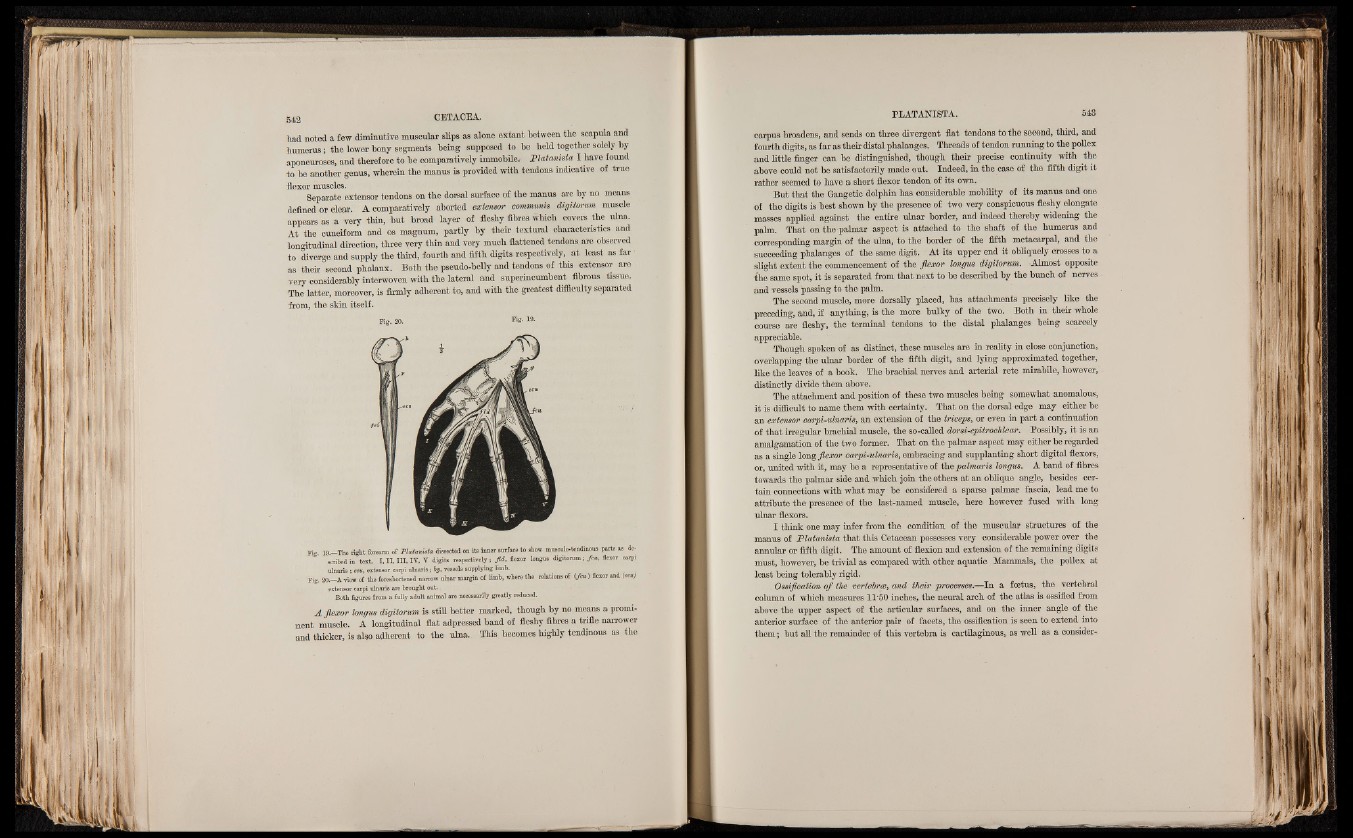
had noted a few diminutive muscular slips as alone extant between the scapula and
humerus; the lower bony segments being supposed to be held together solely by
aponeuroses, and therefore to be comparatively immobile.- Platanista I have found
to be another genus, wherein the manus is provided with tendons indicative of true
flexor muscles.
Separate extensor tendons on the dorsal surface of the manus are by no means
defined or clear. A comparatively aborted extensor commtmis digitonm musole
appears as a very thin, hut broad layer of fleshy fibres which covers the ulna.
At the cuneiform and os magnum, partly by their textural characteristics and
longitudinal direction, three very thin and very much flattened tendons are observed
to diverge and supply the third, fourth and fifth digits respectively, at least as far
as their second phalanx. Both the pseudo-helly and tendons of this extensor are
v e r y c o n s i d e r a b l y interwoven with the lateral and superincumbent fibrous tissue.
The latter, moreover, is firmly adherent to, and with the greatest difficulty separated
from, the skin itself.
Pig. 20. 19-
Pig. 19.—The right forearm of P la tan ista dissected on its inner surface to show museulo-tendinous Parts as described
in text. I, I I, i n , IV, V digits respectively; fid , flexor longus digitorum; feu, flexor carpi
ulnaris ; ecu, extensor carpi ulnaris; by, vessels supplying limb.
Pig. 20.—A view of the foreshortened narrow ulnar margin o f limb, where the relations of (feu ) flexor and {ecu)
extensor carpi ulnaris are brought out.
Both figures from a fully adult animal are necessarily greatly reduced.
A flexor longus digitonm is still better marked, though by no means a prominent
muscle. A longitudinal flat adpressed band of fleshy fibres a trifle narrower
and thicker, is also adherent to the ulna. This becomes highly tendinous as the
carpus broadens, and sends on three divergent flat tendons to the second, third, and
fourth digits, as far as their distal phalanges. Threads of tendon running to the pollex
and little finger can be distinguished, though their precise continuity with the
above could not be satisfactorily made out. Indeed, in the case of the fifth digit it
rather seemed to have a short flexor tendon of its own.
But that the Gangetic dolphin has considerable mobility of its manus and one
of the digits is best shown by the presence of two very conspicuous fleshy elongate
masses applied against the entire ulnar border, and indeed thereby widening the
palm. That on the palmar aspect is attached to the shaft of the humerus and
corresponding margin of the ulna, to the border of the fifth metacarpal, and the
succeeding phalanges of the same digit. At its upper end it obliquely crosses to a
slight extent the commencement of the flexor longus digitorum. Almost opposite
the same spot, it is separated from that next to be described by the bunch of nerves
and vessels passing to the palm.
The second muscle, more dorsally placed, has attachments precisely like the
preceding, and, if anything, is the more bulky of the two. Both in their whole
course are fleshy, the terminal tendons to the distal phalanges being scarcely
appreciable.
Though spoken of as distinct, these muscles are in reality in close conjunction,
overlapping the ulnar border of the fifth digit, and lying approximated together,
like the leaves of a book. The brachial nerves and arterial rete mirabile, however,
distinctly divide them above.
The attachment and position of these two muscles being somewhat anomalous,
it is difficult to name them with certainty. That on the dorsal edge may either be
an extensor carpi-ulnaris, an extension of the triceps, or even in part a continuation
of that irregular brachial muscle, the so-called dorsi-epitrochlear. Possibly, it is an
amalgamation of the two former. That on the palmar aspect may either be regarded
as a single Ion % flexor carpi-ulnaris, embracing and supplanting short digital flexors,
or, united with it, may be a representative of the palmaris longus. A band of fibres
towards the palmar side and which join the others at an oblique angle, besides certain
connections with what may be considered a sparse palmar fascia, lead me to
attribute the presence of the last-named muscle, here however fused with long
ulnar flexors.
I think one may infer from the condition of the muscular structures of the
manus of Platanista that this Cetacean possesses very considerable power over the
a.nnnl».r or fifth digit. The amount of flexion and extension of the remaining digits
must, however, be trivial as compared with other aquatic Mammals, the pollex at
least being tolerably rigid.
Ossification of the vertebrae, and their processes.—In a foetus, the vertebral
column of which measures 11*50 inches, the neural arch of the atlas is ossified from
above the upper aspect of the articular surfaces, and on the inner angle of the
anterior surface of the anterior pair of facets, the ossification is seen to extend into
them; but all the remainder of this vertebra is cartilaginous, as well as a consider